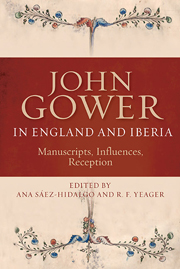Book contents
- Frontmatter
- Contents
- List of Illustrations
- Abbreviations
- Introduction
- I Manuscripts
- II Iberia
- III The Classical Tradition
- IV Economy
- 12 Goods and the Good in the Confessio Amantis
- 13 Gower's Kiste
- 14 John Gower: Balzac of the Fourteenth Century
- 15 Gower's Gifts
- V Reception
- Notes on Contributors
- Bibliography
- Index
14 - John Gower: Balzac of the Fourteenth Century
from IV - Economy
Published online by Cambridge University Press: 05 August 2014
- Frontmatter
- Contents
- List of Illustrations
- Abbreviations
- Introduction
- I Manuscripts
- II Iberia
- III The Classical Tradition
- IV Economy
- 12 Goods and the Good in the Confessio Amantis
- 13 Gower's Kiste
- 14 John Gower: Balzac of the Fourteenth Century
- 15 Gower's Gifts
- V Reception
- Notes on Contributors
- Bibliography
- Index
Summary
I take both my title and the trajectory of my argument from Georg Lukács's famous study of the development of the historical novel. It is a striking fact that as Lukács's history of the genre moves from Sir Walter Scott through the development of nineteenth-century Realism and Naturalism, and then through his own contemporaries, the writerly heroes who emerge, the ones most truly able to exploit the novel's capacity to write “a history of the present,” tend to not, as one might expect, the leftist practitioners of the genre (such as Zola), but, rather, the more ideologically conservative novelists, such as Tolstoy and Balzac. As always with Lukács, this tendency cannot be explained away merely through some psychological profile of the writers involved (though this has its place), but, rather, through the concrete historical situations which these writers encountered and the aesthetic forms through which they sought to represent such situations. In the case of Balzac, for example, Lukács's account centers on a question inescapable in thinking about the particularity of Balzac's career: how did Balzac come to conceive of the project of a vast cycle of novels charting the social types who populated his contemporary world, and what might account for the psychological and social depth of his mass portrait? Lukács's answer hinges on a crucial historical contrast between Balzac and Scott.
- Type
- Chapter
- Information
- John Gower in England and IberiaManuscripts, Influences, Reception, pp. 215 - 228Publisher: Boydell & BrewerPrint publication year: 2014



